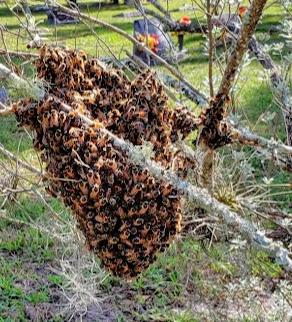Spring is honeybee swarm season.
When flowers start blooming, bees start making honey and bee colonies increase in size, causing them to outgrow their nest. The queen and about half of the worker bees then leave the parent colony to find a new nesting site. This swarm of bees will fly about a mile away (more or less, depending on the availability of potential food and nesting sites). Typically, a swarm will hang out in a large cluster for a day or so, until one of the scout bees has found a suitable nesting site nearby for the colony to settle into. Honeybee swarms will often land on a fence, a tree branch, or building.
Are honeybees dangerous?
Seeing thousands of bees flying or clustering together tends to alarm people. Fear not, swarms are just looking for a new place to live and they won’t bother you. They don’t have a home or babies to look after, so they aren’t defensive. If a honeybee swarm shows up on your property, wait a day or two, and they will normally move on.
Sometimes, a honeybee colony will decide that the best place to start a new nest is in a human habitat. When honeybees establish their new nest near people, there is potentially a risk of stinging incidents. Any animal can become defensive if it feels a need to protect its family and home. Often, people don’t know the nest is there until someone is using lawn equipment nearby and is stung; bees hate weed trimmers. Beekeepers manage European hone bees in human-made hives that are inspected, and placed where they aren’t a risk to people, which is a very different situation than a feral colony establishing itself near humans. If you see a place where bees are coming in and out, then a nest is already established and you should call a bee removal professional. Luckily, you can usually prevent bees from nesting in or near your home.
Bee-proofing your property
Here are some actions that you can take to deter bees and other critters, like ants and rodents, from moving into your home. First, scout your property for potential nest sites. Honeybees prefer dry, enclosed spaces; as a general rule, think of any space that is large enough for a soccer ball to fit into that has an entrance at least the size of a dime. Jason Deeringer of Bee Serious Bee Removal said, “The most frequent calls I have are about bees inside of hollow concrete block walls and utility boxes, even underground meter boxes.”
Bees will also nest in places like roof eaves, chimneys, and porch columns.
“Homeowners should seal any holes with latex sealant or special ‘pest-blocking’ foam. The holes where electrical wires lead into walls are common entrances for bees, like at the back of irrigation or electrical boxes,” said Deeringer.
Larger openings can be covered with metal screening or No. 8 hardware cloth. Install a top damper on chimneys that are used. Monitor equipment stored outdoors: inside of barbecue grills, boats and playground equipment, and under trailers and campers that are used infrequently. Remove or cover items like tires, upside-down pots, and boards leaning against walls. Cover the entrances to bird nesting boxes when it’s not nesting season.
What can a bee removal professional do to minimize stinging risks and homeowner liability when dealing with an established bee colony nesting in a human habitat? “Carry liability insurance, have a Pest Control Operators License, and have knowledge of bees to be able to do the job in the safest way possible,” Deeringer noted.
Honeybees are very valuable to us all, pollinating our crops and providing us with healthful honey. Fortunately, human-bee conflicts are usually avoidable by monitoring nesting hot-spots and excluding them from structures. For more information on bees, beekeeping, or pest management, contact the UF IFAS Extension in Osceola County: http://sfyl.ifas.ufl.edu/osceola/ , 321-697-3000.
Jessica Sullivan as a sustainable agriculture & food systems agent with UF IFAS Extension – Osceola County.




